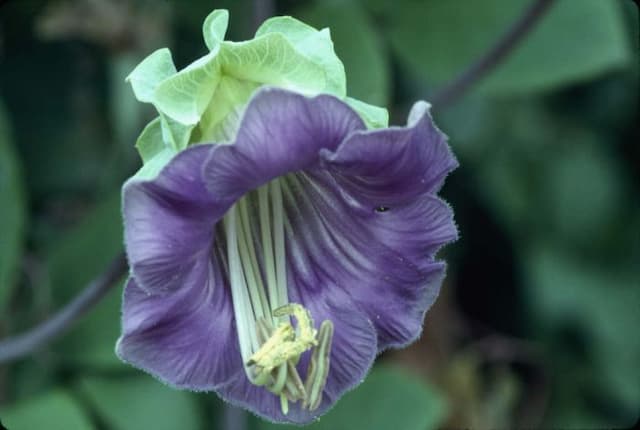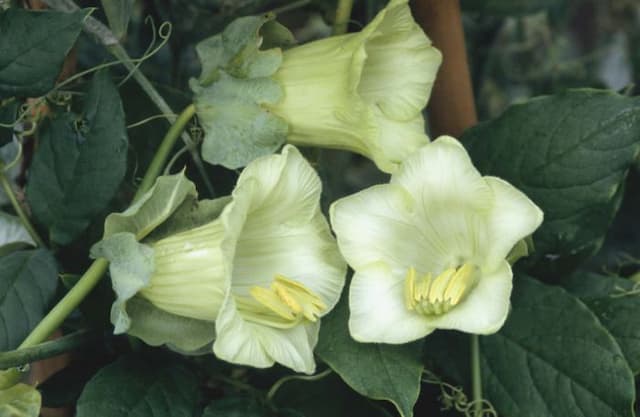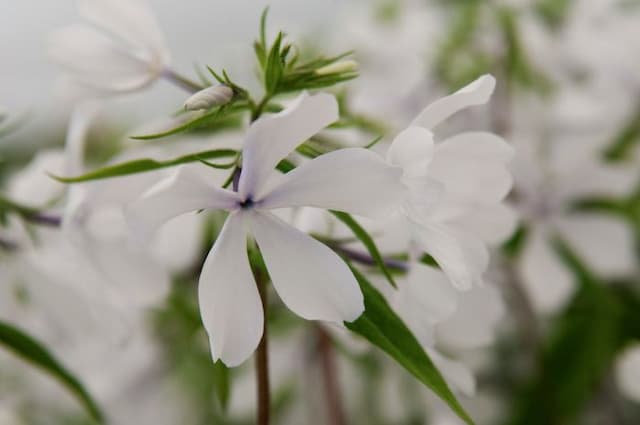Garden Phlox Phlox paniculata 'Danielle'

ABOUT
Phlox paniculata 'Danielle' is a perennial plant known for its attractive clusters of flowers. The flower heads are composed of numerous small, individual blooms which are a crisp white color. Each petal is rounded with a slight point at the end, contributing to a delicate look. The fertilization part at the flower's center, is a subtle, contrasting hue which adds to the visual appeal of the flowers. The plants produce their flowers atop sturdy stems, which are surrounded by lush, green foliage. The leaves are lance-shaped with smooth edges, and they typically have a slightly shiny appearance. This creates a dense backdrop of greenery that beautifully accentuates the bright white blooms. 'Danielle' blooms in the summer months, transforming the garden with its profusion of flowers that can attract pollinators like bees and butterflies. As the plant matures, the bloom clusters can become quite large, providing a striking visual display. The growth habit of Phlox paniculata 'Danielle' is generally upright and clumping, forming a bushy appearance with stems closely packed together. The texture of the plant is somewhat coarse, with the stems and leaves adding to the robustness of the plant's overall appearance. In summary, Phlox paniculata 'Danielle' is a beautiful garden plant with showy white flowers that contrast nicely against green, lance-shaped foliage, contributing a classic and serene look to any garden setting.
About this plant
 Names
NamesSynonyms
Garden Phlox, Summer Phlox, Perennial Phlox, Tall Phlox.
Common names
Phlox paniculata 'Danielle'.
 Toxicity
ToxicityTo humans
Garden Phlox is not commonly known to be toxic to humans. However, sensitive individuals might occasionally experience mild irritation of the skin, eyes, or stomach if they handle or ingest parts of the plant. In general, it is advisable not to ingest any plant material that is not known to be safe for consumption, as individual reactions can vary.
To pets
Garden Phlox is generally considered non-toxic to cats and dogs. It is not usually associated with serious illness if pets ingest it. However, as with any non-food plant, ingestion could potentially lead to mild gastrointestinal upset, such as vomiting or diarrhea, if the animal consumes large quantities or has a sensitive stomach.
 Characteristics
CharacteristicsLife cycle
Perennials
Foliage type
Deciduous
Color of leaves
Green
Flower color
White
Height
2-3 feet (60-90 cm)
Spread
2-3 feet (60-90 cm)
Plant type
Herb
Hardiness zones
4
Native area
North America
Benefits
 General Benefits
General Benefits- Attracts pollinators: Garden Phlox is known for attracting bees, butterflies, and other beneficial insects to the garden, aiding in pollination.
- Aesthetic appeal: With its striking white blooms, 'Danielle' adds visual interest and enhances the beauty of any garden space.
- Fragrant flowers: The blossoms emit a pleasant fragrance that can create an aromatic environment in the surrounding area.
- Long blooming period: This variety of Phlox offers a lengthy blooming period from mid to late summer, providing long-lasting color.
- Versatility in landscaping: Ideal for borders, beds, and as a backdrop to other plants, it effectively fills spaces in a garden design.
- Drought tolerance: Once established, 'Danielle' has a certain degree of drought resistance, making it suitable for varied climatic conditions.
- Easy propagation: Garden Phlox can be easily propagated by dividing clumps, allowing gardeners to expand their plantings with minimal effort.
 Medical Properties
Medical PropertiesThis plant is not used for medical purposes.
 Air-purifying Qualities
Air-purifying QualitiesThis plant is not specifically known for air purifying qualities.
 Other Uses
Other Uses- Garden borders: Phlox 'Danielle' is typically used for its ornamental value and can create a stunning, dense border in a garden display.
- Butterfly gardens: The species is known for attracting butterflies, making it a perfect addition to butterfly gardens to encourage pollinator visits.
- Cut flower gardens: Its long-lasting blooms and sturdy stems make 'Danielle' an excellent option for those who wish to grow flowers specifically for cutting and indoor arrangements.
- Perfumery: The sweet scent of Phlox 'Danielle' can be used in the production of perfumes and other fragranced products.
- Wedding decor: The delicate white flowers can be incorporated into wedding bouquets or decorations for a natural and romantic touch.
- Crafting: Dried Phlox blooms can be used in creating craft items such as potpourri, wreaths, or dried floral displays.
- Privacy screens: Taller varieties of Phlox, like 'Danielle', can be planted in rows to create a natural privacy screen in the garden.
- Educational use: Phlox species can be used as an educational tool in botanical and horticultural studies due to their varied genetics and hybridization potential.
- Theme gardening: 'Danielle’s' pure white blossoms make it suitable for moon gardens, which are designed to be enjoyed in the evening.
- Photography: The flowers’ visual appeal makes them a great subject for garden photography and botanical art.
Interesting Facts
 Feng Shui
Feng ShuiThe Garden Phlox is not used in Feng Shui practice.
 Zodiac Sign Compitability
Zodiac Sign CompitabilityThe Garden Phlox is not used in astrology practice.
 Plant Symbolism
Plant Symbolism- Harmony: Garden Phlox, like Phlox paniculata 'Danielle', symbolize harmony and is often used in gardens to create a balanced and unified aesthetic.
- Partnership: The clusters of flowers represent the unity of individuals, making the plant a symbol of strong partnership and relationships.
- Sweet Dreams: Due to the sweet fragrance of Phlox flowers, they are believed to evoke sweet dreams and are sometimes associated with tranquility in sleep.
- Proposal: In the language of flowers, Phlox can be used to symbolize a marriage proposal, suggesting the speaker's desire to unite their dreams with the recipient.
- Agreement: The cohesive look of the flower clusters can signify agreement, suggesting harmony in thoughts or feelings between people.
 Water
WaterGarden Phlox should be watered deeply but infrequently to encourage deep root growth, typically about once a week. The exact frequency can vary depending on climate and soil conditions; however, it is crucial to keep the soil consistently moist, especially during hot, dry periods. A general guideline is to provide about one inch of water per week, either from rainfall or supplementary watering. When watering Garden Phlox, it is important to water at the soil level and avoid wetting the foliage to reduce the risk of fungal diseases. Overwatering should be avoided, as this can lead to root rot.
 Light
LightThe Garden Phlox thrives best in full sun, meaning at least six hours of direct sunlight each day. However, it can tolerate partial shade, especially in hotter climates where some afternoon shade can protect it from the intense heat of the late day. An ideal spot would provide morning sunlight and some protection from the harsh afternoon sun, promoting healthy bloom and growth.
 Temperature
TemperatureGarden Phlox is hardy and can tolerate temperatures down to about -30 degrees Fahrenheit, surviving winter in many climates. The ideal temperature range for active growth is between 60 and 70 degrees Fahrenheit. It can withstand summer temperatures up to around 90 degrees Fahrenheit, but prolonged heat and humidity without adequate air circulation can increase the risk of powdery mildew and other diseases.
 Pruning
PruningPruning Garden Phlox is important to promote vigorous growth and to maintain a neat appearance. After the initial bloom, deadhead spent flowers to encourage a second flowering. In late fall or early spring, cut back the entire plant to about one or two inches above the soil to help rejuvenate it for the next season. Pruning also helps prevent overcrowding and increases air circulation, which is essential for minimizing the risk of fungal diseases.
 Cleaning
CleaningAs needed
 Soil
SoilGarden Phlox (Phlox paniculata 'Danielle') thrives in a soil mix that is rich in organic matter, well-draining, and has a pH of 6.0 to 7.0. A good mix could be composed of equal parts garden soil, compost, and perlite or coarse sand to enhance drainage.
 Repotting
RepottingGarden Phlox (Phlox paniculata 'Danielle') does not typically require repotting as it is generally grown as a perennial in gardens. In outdoor settings, it can be divided every 3 to 4 years to rejuvenate and spread the plant.
 Humidity & Misting
Humidity & MistingGarden Phlox (Phlox paniculata 'Danielle') prefers average humidity conditions and is tolerant of the humidity levels typically found in outdoor garden environments.
 Suitable locations
Suitable locationsIndoor
Place in well-lit area, ensure good air circulation.
Outdoor
Ensure full sun to partial shade, rich soil, good drainage.
Hardiness zone
4-8 USDA
 Life cycle
Life cyclePhlox paniculata 'Danielle', commonly known as Garden Phlox, begins its life cycle as a seed that germinates in the spring when soil temperatures warm up. The seedling emerges and develops into a young plant with a rosette of leaves at the soil level. Throughout the growing season, the plant grows vigorously and produces sturdy stems and foliage, eventually reaching its mature height. By mid to late summer, Garden Phlox blooms, displaying clusters of fragrant, pure white flowers that attract pollinators such as butterflies and bees. After pollination, the flowers develop into seed capsules, which release their seeds to complete the cycle. As a perennial, the plant dies back to ground level in the fall with its root system remaining alive underground, ready to re-sprout the following spring.
 Propogation
PropogationPropogation time
Spring to Summer
The garden phlox, known botanically as Phlox paniculata 'Danielle', can be propagated effectively through stem cuttings, a popular method practiced by gardeners. The best time to take stem cuttings is in early to mid-summer, when the plant is in a phase of active growth. To propagate by stem cuttings, you would cut a 4 to 6-inch (10 to 15 cm) portion of a healthy and non-flowering stem, making sure to include several leaf nodes. Strip the leaves from the lower half of the cutting and dip the cut end into a rooting hormone to facilitate root development. Then, insert the cutting into a moist potting mix, ensuring it remains upright and the leaf nodes where you removed leaves are below the soil surface. The pot should be placed in indirect light and kept at a consistent moisture level until roots have established, after which the new plants can be transplanted to a permanent location in the garden.









